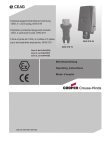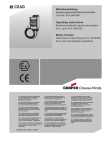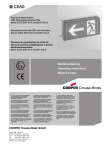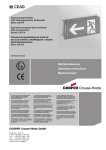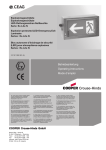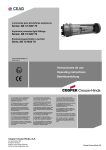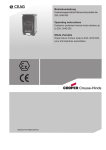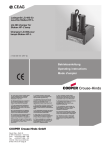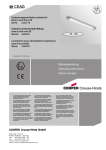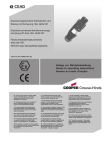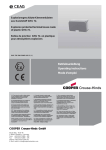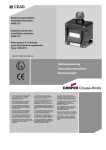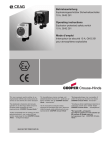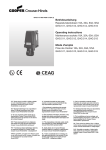Download Betriebsanleitung Operating instructions Mode d'emploi
Transcript
Betriebsanleitung Explosionsgeschützte Klemmenkästen GHG 731 Operating instructions Explosion protected terminal boxes GHG 731 Mode d’emploi Boites de bornes GHG 731 pour atmosphères explosives &=7HQWRQiYRGNSRXåLWtVLPåHWHY\åiGDW YHVYpPPDWHĜVNpPMD]\FHXSĜtVOXãQpKR ]DVWRXSHQtVSROHþQRVWL&RRSHU&URXVH +LQGV&($*YHYDãt]HPL +$NH]HOpVL~WPXWDWyWD]DGRWWRUV]iJ Q\HOYpQD&RRSHU&URXVH+LQGV&($*FpJ KHO\LNpSYLVHOHWpQLJpQ\HOKHWLPHJ '.0RQWDJHYHMOHGQLQJHQNDQRYHUV WWHVWLO DQGUH(8VSURJRJUHNYLUHUHVKRV'HUHV &RRSHU&URXVH+LQGV&($*OHYHUDQG¡U ,6HGHVLGHUDWHODWUDGX]LRQHGHOPDQXDOH RSHUDWLYRLQXQDOWUDOLQJXDGHOOD&RPXQLWj (XURSHDSRWHWHULFKLHGHUODDOYRVWUR UDSSUHVHQWDQWH&RRSHU&URXVH+LQGV&($* ((QFDVRQHFHVDULRSRGUiVROLFLWDUGHVX UHSUHVHQWDQWH&RRSHU&URXVH+LQGV&($* HVWDVLQVWUXFFLRQHVGHVHUYLFLRHQRWURLGLRPD GHOD8QLRQ(XURSHD /7âLRVQDXGRMLPRLQVWUXNFLMRVLãYHUVWRVƳ-njVǐ JLPWąMąNDOEąJDOLWHSDUHLNDODXWLDWVDNLQJRMH &RRSHU&URXVH+LQGV&($*DWVWRY\EHMHVDYR ãDO\MH (676HGDNDVXWXVMXKHQGLWRPDULLJLNHHOHV Y}LWHNVLGDRPDULLJLVDVXYDVWDVMDRPDVHVW &RRSHU&URXVH+LQGVL&($*HVLQGXVHVW /9âRHNVSOXDWƗFLMDVLQVWUXNFLMXYDOVWVYDORGƗ YDUDWSLHSUDVƯWMXVXYDOVWVDWELOGƯJDMƗ&RRSHU &URXVH+LQGV&($*SƗUVWƗYQLHFƯEƗ ),17DUYLWWDHVVDWlPlQNl\WW|RKMHHQNllQQ|V RQVDDWDYLVVDWRLVHOOD(8QNLHOHOOl7HLGlQ &RRSHU&URXVH+LQGV&($*HGXVWDMDOWDQQH 0-LVWJƫXMLWROEXGDQLOPDQZDOILOOLQJZD QD]]MRQDOLWDJƫKRPPLQJƫDQGLUUDSSUHĪHQWDQW WD &RRSHU&URXVH+LQGV&($*I SDMMLĪKRP *5ǼĮȞȤȡİȚĮıșİȚİIJĮȡĮıȘIJȦȞȠįȘȖȚȦȞȤȡȘıİ ȦȢıİĮȜȜȘȖȜȦııĮIJȘȢǼǼʌȠȡİȚȞĮȗȘIJȘșİȚĮʌȠ IJȠȞǹȞIJȚʌȡȠıȦʌȠIJȘȢ&RRSHU&URXVH +LQGV&($*³ 1/,QGLHQQRRG]DNHOLMNNDQGHYHUWDOLQJYDQ GH]HJHEUXLNVLQVWUXFWLHLQHHQDQGHUH(8WDDO ZRUGHQRSJHYUDDJGELM8Z&RRSHU&URXVH +LQGV&($*YHUWHJHQZRRUGLJLQJ GHG 730 7001 P0001 D/E/F (I) 36HIRUQHFHVViULDDWUDGXomRGHVWDV LQVWUXo}HVGHRSHUDomRSDUDRXWURLGLRPDGD 8QLmR(XURSHLDSRGHVROLFLWDODMXQWRGRVHX UHSUHVHQWDQWH&RRSHU&URXVH+LQGV&($* 3/1LQLHMV]ąLQVWUXNFMrREVáXJLZRGSRZLHGQLHM ZHUVMLMĊ]\NRZHMPRĪQD]DPyZLüZ SU]HGVWDZLFLHOVWZLHILUP\&RRSHU&URXVH +LQGV&($*QDGDQ\NUDM 6(Q|YHUVlWWQLQJDYGHQQDPRQWDJHRFK VN|WVHOLQVWUXNWLRQWLOODQQDW(8VSUnNNDQYLG EHKRYEHVWlOODVIUnQ(U&RRSHU&URXVH +LQGV&($*UHSUHVHQWDQW 6.7HQWRQiYRGQDREVOXKX9iPYR9DãRP URGQRPMD]\NXSRVN\WQH]DVW~SHQLHVSRORþQRVWL &RRSHU&URXVH+LQGV&($*YR9DãHMNUDMLQH 6/21DYRGLOD]DXSRUDERY9DãHPMH]LNX ODKNR]DKWHYDWHSULSULVWRMQHP]DVWRSQLãWYX SRGMHWMD&RRSHU&URXVH+LQGV&($*Y9DãL GUåDYL Inhalt: 1 2 3 4 5 6 6.1 6.2 6.3 6.4 6.5 7 8 9 10 Contents: Inhalt.................................. Maßbilder.......................... Technische Angaben......... Sicherheitshinweise.......... Normenkonformität........... Verwendungsbereich......... Verwendung/ Eigenschaften................. Installation....................... Montage........................... Öffnen des Gerätes/ Elektrischer Anschluss.... Kabel- und Leitungseinführung; Verschlussstopfen............................ Schließen des Gerätes.... Inbetriebnahme............... Instandhaltung / Wartung Reparatur / Instandsetzung/ Änderungen...... Entsorgung / Wiederverwertung....................... Konformitätserklärung..... 2 2 3 3 4 4 4 4 4 1 2 3 4 5 6 6.1 6.2 4 6.3 5 5 5 5 6.4 6.5 7 8 9 10 5 5 12 Contents............................. Dimensional drawings......... Technical Data..................... Safety instructions............... Conformity with standards Field of application............... Application/ Properties......... Installation............................ Mounting.............................. Opening the device / Electrical connection............ Cable entry (KLE); blanking plug....................... Closing the device................ Taking into operation............ Maintenance/Servicing......... Repairs/Modification............. Disposal/Recycling............... Declaration of conformity...... Contenu: 2 6 6 7 7 7 7 7 7 7 8 8 8 8 8 8 12 1 2 3 4 5 6 6.1 6.2 6.3 6.4 6.5 7 8 9 10 2 Cooper Crouse-Hinds GmbH Contenu................................ Plans cotés........................... Caractéristiques techniques............................ Consignes de sécurité........... Conformité avec les normes.................................. Domaine d’utilisation............. Utilisation/Propriétés............. Installation............................ Montage................................ Ouverture de la boite / Raccordement électrique...... Entrées de câble (KLE) bouchons de fermeture......... Fermeture de la boite / Fermeture du couvercle........ Mise en service.................... Maintien/Entretien................ Réparation/Remise en état.................................. Évacuation des déchets/ Recyclage............................ Déclaration de conformité... 2 9 9 10 10 10 10 10 10 10 11 11 11 11 11 11 12 Maßangaben in mm X = Befestigungsmaße 1 Technische Angaben Klemmenkästen GHG 731 Gerätekennzeichnung nach 94/9/EG: EG-Baumusterprüfbescheinigung: Bemessungsspannung: Bemessungsstrom: Zulässige Umgebungstemperatur: GHG 731 01 GHG 731 02 Abweichende Temperaturen sind bei Sonderversionen möglich) Zul. Lagertemperatur in Originalverpackung: Schutzart nach EN/IEC 60529: Schutzklasse nach EN/IEC 61140: Anschlussklemmen: GHG 731 01, GHG 731 02, GHG 731 03 GHG 731 11 GHG 731 12 Leitungseinführungen: Prüfdrehmomente: Deckelschrauben Druckschraube der KLE M12 Druckschraube der KLE M16 Druckschraube der KLE M20 Druckschraube der KLE M25 Druckschraube der KLE M32 - KLE M50 Leergewicht: GHG 731 01 GHG 731 02 GHG 731 03 GHG 731 11 GHG 731 12 II 2 G Ex de ia/ib [ia/ib] II C T6 II 2 D Ex tD A21 IP66 T80°C PTB 99 ATEX 1044 bis 690 V siehe Tabelle im Gehäusedeckel -20° C bis +40° C (Listenausführung) -40° C bis +80° C IP 66 (Listenausführung) I - mit innenliegender Metallplatte II - wird von den Klemmenkästen erfüllt laut Auftrag - im Rahmen der Bescheinigung max. 4,0 mm² max. 16,0 mm² max. 16,0 mm² laut Auftrag - im Rahmen der Bescheinigung 2,50 1,65 2,50 2,50 3,50 5,00 ca. ca. ca. ca. ca. Nm Nm Nm Nm Nm Nm 0,25 0,35 0,45 0,77 0,92 kg kg kg kg kg GHG 731 03 GHG 731 11 GHG 731 12 Cooper Crouse-Hinds GmbH 3 2 Bild 1 Sicherheitshinweise Die Zielgruppe dieser Anleitung sind Elektrofachkräfte und Unterwiesene Personen in Anlehnung an IEC 60079-14. Die Klemmenkästen GHG 731 sind nicht für Zone 0 und Zone 20 geeignet. Die auf den Klemmenkästen angegebene Temperaturklasse und Explosionsgruppe ist zu beachten. 1 2 Die Anforderungen der EN 61241-0 und -1 u.a. in Bezug auf übermäßige Staubablagerungen und Temperatur, sind vom Anwender zu beachten. Umbauten oder Veränderungen an den Klemmenkästen sind nicht gestattet. Sie sind bestimmungsgemäß in unbeschädigtem und einwandfreiem Zustand zu betreiben. Als Ersatz und zur Reparatur dürfen nur Originalteile von COOPER CROUSEHINDS / CEAG verwendet werden. Reparaturen, die den Explosionsschutz betreffen, dürfen nur von COOPER CROUSE-HINDS / CEAG oder einer qualifizierten Elektrofachkraft in Übereinstimmung mit national geltenden Regeln durchgeführt werden. Vor Inbetriebnahme müssen die Klemmenkästen entsprechend der im Abschnitt 6 genannten Anweisung geprüft werden. Alle Fremdkörper müssen vor der ersten Inbetriebnahme aus den Klemmenkästen entfernt werden. Beachten Sie die nationalen Sicherheitsund Unfallverhütungsvorschriften und die nachfolgenden Sicherheitshinweise in dieser Betriebsanleitung, die wie dieser Text in Kursivschrift gefasst sind! 3 Normenkonformität Das Betriebsmittel ist gemäß DIN EN ISO 9001 entwickelt, gefertigt und geprüft worden. Es entspricht den in der Konformitätserklärung aufgeführten Normen. 94/9 EG: Geräte und Schutzsysteme zur bestimmungsgemäßen Verwendung in explosionsgefährdeten Bereichen. Weitere Anforderungen wie die EG Richtlinie Elektromagnetische Verträglichkeit (2004/108/ EG) werden von den Betriebsmitteln erfüllt. 4 Verwendungsbereich Die Klemmenkästen sind zum Einsatz in explosionsgefährdeten Bereichen der Zonen 1, 2 gemäß IEC 60079-10 und IEC 60079-14 geeignet! Die eingesetzten Gehäusematerialien einschließlich der außenliegenden Metallteile bestehen aus hochwertigen Werkstoffen, die einen anwendungsgerechten Korrosionsschutz und Chemikalienresistenz in "normaler Industrieatmosphäre" gewährleisten: - schlagfestes Polyamid - schlagfestes Polyester - Edelstahl AISI 316 L. - Buntmetall Vernickelt 4 Cooper Crouse-Hinds GmbH Bei einem Einsatz in extrem aggressiver Atmosphäre, können Sie zusätzliche Informationen über die Chemikalienbeständigkeit der eingesetzten Kunststoffe, bei Ihrer zuständigen Cooper Crouse-Hinds Niederlassung erfragen. 5 Verwendung / Eigenschaften Die Klemmenkästen dienen zum Verteilen elektrischer Energie z.B. Lichtstromkreise Heizstromkreise, Steuerstromkreise, eigensichere Stromkreise usw. in explosionsgefährdeten Bereichen (siehe technische Daten). Temperaturklasse, Explosionsgruppe, zulässige Umgebungstemperatur, siehe technische Daten. Die Klemmenkästen sind auch im "normalen Industriebereich" verwendbar. Angaben aus Punkt 3 und 4 sind bei der Verwendung zu berücksichtigen. Andere als die beschriebenen Anwendungen sind ohne schriftliche Erklärung der Fa. COOPER CROUSE-HINDS / CEAG nicht zulässig. Beim Betrieb sind die in der Betriebsanleitung unter Punkt 7 genannten Anweisungen zu beachten. Die Verantwortung hinsichtlich bestimmungsgemäßer Verwendung dieser Klemmenkästen unter Bezugnahme der in der Anlage vorhandenen Rahmenbedingungen (s. technische Daten) liegt allein beim Betreiber. 6 Installation Für das Errichten / Betreiben sind die relevanten nationalen Vorschriften (z.B. Betr.Si.V.) Gerätesicherheitsgesetz in Deutschland) sowie die allgemein anerkannten Regeln der Technik maßgebend. 6.1 Montage Die Montage der Klemmenkästen kann ohne Öffnen des Gehäuses erfolgen. Sie dürfen bei der Direktmontage an der Wand nur an den vorgesehenen Befestigungspunkten eben aufliegen. Die gewählte Schraube muß der Befestigungsöffnung angepaßt sein (siehe Maßbild) und sie darf die Öffnung nicht beschädigen (z.B. Verwendung einer Unterlegscheibe). Die Klemmenkästen sind mit mindestens 2 Schrauben diagonal zu befestigen. Durch entriegeln des Verriegelungschiebers, Pos 2, Bild 1, am Klemmentragschienenhalter, Pos. 1, Bild 1, mit einem geeigneten Werkzeug (z.B. eines Schraubendrehers) kann die Klemmentragschiene mit Halter aus dem Gehäuseunterteil gelöst werden. Zum Einbau wird der Klemmentragschienenhalter in die Rastnocke im Gehäuseboden eingesetzt und eingeschnappt (siehe Bild 1). Bei übermäßigem Anziehen der Befestigungsschrauben kann der Klemmenkasten beschädigt werden. 6.2 Öffnen des Gerätes/ Elektrischer Anschluss Der elektrische Anschluss des Betriebsmittels darf nur durch Elektrofachpersonal erfolgen. Die Isolation der Anschlussleitungen muss bis an die Klemme heranreichen. Der Leiter selbst darf nicht beschädigt sein. Die ordnungsgemäß abisolierten Anschlussleitungen der Kabel sind unter Berücksichtigung einschlägiger Vorschriften anzuschließen. Die minimal und maximal anschließbaren Leiterquerschnitte sind zu beachten (siehe technische Daten). Alle Schrauben und /oder Muttern der Anschlussklemmen, auch die der nicht benutzten, sind fest anzuziehen. Zur Aufrechterhaltung der Zündschutzart ist der Leiteranschluss mit besonderer Sorgfalt durchzuführen. Die Anschlussklemmen sind für den Anschluss von Kupferleitern ausgelegt. Bei der Verwendung von mehr- oder feindrähtigen Anschlusskabel und Anschlussleitungen sind die Aderenden entsprechend den geltenden nationalen und internationalen Vorschriften zu behandeln (z.B. Verwendung von Aderendhülsen). Die im Deckel der Klemmenkästen angegebene Strombelastungstabelle ist zu beachten. Bei Mischbestückungen Ex - e / Ex - i sind die erforderlichen Mindestabstände einzuhalten (siehe z.B. EN 60079-11). Nach der Demontage der Klemmentragschiene, Pos 1, Bild1, (zur leichteren Einführung der Kabel und Leitungen), muß vor dem elektrischen Anschluß die Klemmentragschiene wieder ordnungsgemäß montiert werden. Die Demontage und Montage erfolgt, wie nachfolgend beschrieben: Durch entriegeln des Verriegelungschiebers, Pos 2, Bild 1, am Klemmentragschienenhalter, Pos. 1, Bild 1, mit einem geeigneten Werkzeug (z.B. eines Schraubendrehers) kann die Klemmentragschiene mit Halter aus dem Gehäuseunterteil gelöst werden. Zum Einbau wird der Klemmentragschienenhalter in die Rastnocke im Gehäuseboden eingesetzt und eingeschnappt (siehe Bild 1). 6.3 Kabel-und Leitungseinführungen (KLE); Verschlussstopfen Es dürfen generell nur bescheinigte KLE und Verschlussstopfen verwendet werden. Für bewegliche Leitungen sind Trompetenverschraubungen oder andere geeignete Einführungen mit zusätzlicher Zugentlastung zu verwenden. Die für die eingebauten KLE maßgebenden Montagerichtlinien sind zu beachten. Beim Einsatz von KLE mit einer niedrigeren als der für das Gerät zutreffenden IPSchutzart (Siehe technische Daten, Seite 3) wird die IP-Schutzart des gesamten Gerätes reduziert. Beim Anschluß des Betriebsmittels bzw. bei der Leitungseinführung in das Betriebsmittel sind bei Einsatz von Mitteln mit getrennter Prüfbescheinigung die, falls vorhanden, jeweiligen Anforderungen des Anschlußmittel zu beachten. Nicht benutzte Einführungsöffnungen sind mit einem bescheinigten Verschlussstopfen zu verschließen, um die Mindestschutzart herzustellen. Es ist darauf zu achten, daß bei der Installation der KLE die für den Leitungsdurchmesser geeigneten Dichtungseinsätze verwendet werden. Bei ausschneidbaren Dichtungseinsätzen ist sicherzustellen,daß der Einsatz ordnungsgemäß dem Leitungsdurchmesser angepaßt wird. Alle nicht benutzten metrischen COOPER CROUSE-HINDS / CEAG KLE sind mit dem bescheinigten Verschluß für metrische KLE zu verschließen. Zur Sicherstellung der erforderlichen Mindestschutzart sind die KLE fest anzuziehen. Bei übermäßigem Anziehen kann die Schutzart beeinträchtigt werden. Achtung: Die Metallplatten und Metallverschraubungen müssen in den Potentialausgleich miteinbezogen werden. 6.4 Schließen des Gerätes Alle Fremdkörper sind aus dem Gerät zu entfernen. Zur Sicherstellung der erforderlichen Mindestschutzart sind die Deckelschrauben fest anzuziehen. Bei übermäßigem Anziehen kann die Schutzart beeinträchtigt werden. Wird das Betriebsmittel in der Ausführung "Schutzisoliert" ausgeführt, kann das entsprechende Klebeschild ( ) GHG 905 1002 P0005 beim Hersteller angefordert werden. 6.5 Wird die eingebaute Klemmentragschiene nicht komplett mit Reihenklemmen bestückt, muss die Klemmentragschiene in den Potentialausgleich mit einbezogen werden. Außerdem ist vor der Inbetriebnahme die korrekte Funktion und Installation des Betriebsmittels in Übereinstimmung mit dieser Betriebsanleitung und anderen anwendbaren Bestimmungen zu überprüfen. 7 Instandhaltung / Wartung Die für die Wartung / Instandhaltung von elektrischen Betriebsmitteln in explosionsgefährdeten Bereichen geltenden nationalen Bestimmungen sind einzuhalten (EN 60079-17). Vor Öffnen des Gehäuses Spannungsfreiheit sicherstellen bzw. geeignete Schutzmaßnahmen ergreifen. Bei eigensicheren Stromkreisen ist das Arbeiten unter Spannung zulässig. Die erforderlichen Wartungsintervalle sind anwendungsspezifisch und daher in Abhängigkeit von den Einsatzbedingungen vom Betreiber festzulegen. Im Rahmen der Wartung sind vor allem die Teile, von denen die Zündschutzart abhängt, zu prüfen (z.B. Unversehrtheit des Gehäuses, der Dichtungen und der Kabel- und Leitungseinführungen). Sollte bei einer Wartung festgestellt werden, daß Instandsetzungsarbeiten erforderlich sind, ist Abschnitt 8 dieser Betriebsanleitung zu beachten. 8 Reparatur / Instandsetzung / Änderungen Instandsetzungsarbeiten / Reparaturen dürfen nur unter Verwendung von COOPER CROUSE-HINDS / CEAG Originalersatzteilen vorgenommen werden. Reparaturen, die den Explosionsschutz betreffen, dürfen nur von COOPER CROUSE-HINDS / CEAG oder einer qualifizierten Elektrofachkraft in Übereinstimmung mit national geltenden Regeln durchgeführt werden (EN 60079-19). Umbauten oder Änderungen am Betriebsmittel sind nicht gestattet; ausgenommen ist das Anbringen von zusätzlichen KLE und das Montieren von Anschlussklemmen im Rahmen der Zulassung des Betriebsmittels. 9 Entsorgung / Wiederverwertung Bei der Entsorgung des Betriebsmittels sind die jeweils geltenden nationalen Abfallbeseitigungsvorschriften zu beachten. Zur Erleichterung der Wiederverwertbarkeit von Einzelteilen sind Kunststoffteile mit dem Kennzeichen des verwendeten Kunststoffes versehen. Programmänderungen und -ergänzungen sind vorbehalten. Inbetriebnahme Vor Inbetriebnahme des Betriebsmittels sind die in den einzelnen nationalen Bestimmungen genannten Prüfungen durchzuführen. Unsachgemäße Installation und Betrieb der Klemmenkästen kann zum Verlust der Garantie führen. Cooper Crouse-Hinds GmbH 5 Dimensions in mm X = fixing dimensions 1 Technical data Terminal box GHG 731 Marking acc. to 94/9/EC: EC type examination certificate: Rated voltage: Rated current: Perm. ambient temperature: II 2 G Ex de ia/ib [ia/ib] II C T6 II 2 D Ex tD A21 IP66 T80°C PTB 99 ATEX 1044 up to 690 V acc. to table on the inside of the enclosure cover -20° C up to +40° C (catalogue version) Special versions permit deviating temperature ranges. Perm. storage temperature in original packing: Protection category acc. to EN/IEC 60529: Insulation class acc. to EN/IEC 61140: Terminal box GHG 731 01 Terminal box GHG 731 02 Terminal box GHG 731 03 Terminal box GHG 731 11 Terminal box GHG 731 12 6 Cooper Crouse-Hinds GmbH Supply terminal: GHG 731 01, GHG 731 02, GHG 731 03 GHG 731 11 GHG 731 12 Cable entries: Test torques: Cover screws Cap nut of the M12 entry Cap nut of the M16 entry Cap nut of the M20 entry Cap nut of the M25 entry Cap nut of the M32 entry - M63 entry Empty weight: GHG 731 01 GHG 731 02 GHG 731 03 GHG 731 11 GHG 731 12 -40° C up to +80° C IP 66 (catalogue version) I - with internal earth plate II - is complied with by the terminal boxes acc. to customers specification and as certificate max. 4.0 mm² max. 16.0 mm² max. 16.0 mm² acc. to customers specification and as certificate 2.50 1.65 2.50 2.50 3.50 5.00 Nm Nm Nm Nm Nm Nm approx. approx. approx. approx. approx. 0.25 0.35 0.45 0.77 0.92 kg kg kg kg kg 2 Safety instructions The operations must be carried out by electrical suitably trained in hazardous area with knowledge of increased safty explosion protection IEC 60079-14. The terminal boxes GHG 731 are not suitable for Zone 0 and Zone 20 hazardous areas. The requirements of the EN 61241-0 and -1 regarding excessive dust deposits and temperature to be considered from the user. The temperature class and explosion group marked on the terminal boxes shall be observed. Modifications to the terminal boxes or changes of their design are not permitted. They shall be used for their intended purpose and in perfect and clean condition. For replacement and repair only genuine COOPER CROUSE-HINDS / CEAG spare parts shall be used. Repairs that affect the explosion protection, may only be carried out by COOPER CROUSE-HINDS / CEAG or a qualified electrician in compliance with the respective national regulations. Prior to taking the terminal boxes into operation, they shall be checked in accordance with the instruction as per section 6. Before the initial operation, any foreign matter shall be removed from the terminal boxes. Observe the national safety rules and regulations for prevention of accidents as well as the safety instructions included in these operating instructions and set in italics the same as this text! 3 Conformity with standards The apparat is conform to the standards specified in the EC-Declaration of conformity. It has been designed, manufactured and tested according to the state of the art and to DIN EN ISO 9001. protection and resistance to chemical substances corresponding to the requirements in a “normal industrial atmosphere”: - impact resistant polyamide - impact resistant polyester - special steel AISI 316 L - Non-ferrous metal In case of use in an extremely aggresive atmosphere, please refer to manufacturer. 5 Use/Properties The terminal boxes are intended for the distribution of electrical energy e.g. light circuits, heater circuits, control circuits, intrinsically safe circuits etc. in hazardous areas (see technical data). Temperature class, explosion group and permissible ambient temperature, see technical data. The terminal boxes can also be used in a „normal industrial area“. The data as per point 3 and 4 shall be taken into account with the use. Applications other than described are not permitted without COOPER CROUSEHINDS / CEAG’s prior written consent. For the operation, the instructions stated in section 7 of the operating instructions shall be observed. The user alone is responsible for the appropriate use of this terminal box in consideration of the basic conditions existing at the plant (see technical data). 6 Installation For the mounting and operation, the respective national regulations (e.g. Betr.Si.V.) , equipment safety law for Germany) as well as the general rules of engineering shall be observed. 6.1 Mounting The terminal boxes can be mounted without opening their enclosure. In case the terminal boxes are mounted directly onto the wall, they may rest evenly only at the respective fastening points. The chosen screw shall match the fastening hole (see dimensional drawing) and it must not damage the hole (e. g. use of a washer). The device shall be fastened diagonally with at least 2 screws. 94/9 EC: Equipment and protective systems intended for use in potentially explosive atmospheres. The apparats fulfil further requirements, such as the EC directive on electromagnetic compatibility (2004/108/EC) If the screws are overtightened, the apparatus can be damaged. 4 The electrical connection of the device may only be carried out by skilled staff. Field of application The terminal boxes are suitable for use in Zone 1 and 2 hazardous areas acc. IEC 60079-10! The enclosure materials employed, including the exterior metal parts, are made of highquality materials which ensure a corrosion 6.2 The connectible min. and max. conductor cross-sections will have to be observed (see technical data). All screws and/or nuts of the supply terminals, also of those remaining unused, shall be tightened down. The conductors shall be connected with special care in order to maintain the explosion category. The supply terminals are designed for the connection of copper conductors. If multi- or fine-wire connecting cables are used, the wire ends will have to be handled in acc. with the applicable national and international rules (e. g. use of ferrules). The table indicating the current load values which is provided on the cover inside of the terminal boxes is to be observed. In case of mixed equipment Ex e / Ex-i, the required minimum distances will have to be kept (see e.g. EN 60079-11). After removing the terminal rail, item 1, fig. 1, (in order to facilitate the entry of cables), the terminal rail shall again be propperly put in place before establishing the electrical connection. Removal and mounting of the terminal rail are performed as follows: The terminal rail with holder can be removed from the enclosure base by releasing the lock bolt, item 2, fig. 1, on the terminal rail holder, item 1, fig. 1, with a suitable tool (e.g. screwdriver). The terminal rail holder is installed by inserting it into the cam in the bottom of the enclosure and snapping it into position (see fig. 1). In the case of building up the electrical equipment in the "protective insulation" version, appropriate sticker ( ) GHG 905 1002 P0005 can be requested by the manufacturer. If the inserted terminal rail is not equipped completely with line-up terminals, the terminal rail must be included in the equipotential earth connection also. Fig. 1 Opening the device/ Electrical connection The insulation of the conductors shall reach up to the terminal. The conductor itself shall not be damaged. The properly bared conductors of the cables shall be connected, taking into account the respective regulations. 1 Cooper Crouse-Hinds GmbH 2 7 6.3 Cable entries (KLE); blanking plugs Generally, only certified cable entries and blanking plugs may be used. Flexible cables are to be used with trumpetshaped cable glands or other suitable entries with additional pull-relief. The mounting directives applicable to the fitted cable entries are to be observed. When using cable entries with a lower IP protection than that which applies to the device (see technical data, page 6), the IP protection of the whole device will be reduced. When using apparatus or cable entries for the connection to or into the apparatus, when applicable, the relevant special conditions for safe use given in the individual certificates shall be considered. In order to establish the minimum protection category, unused holes have to be closed with a certified blanking plug. Care has to be taken that when fitting the cable entries, sealing inserts appropriate to the cable diameter are used. In case of sealing inserts that are cut out, it will have to be ensured that the insert is properly adapted to the cable diameter. All vacant metric COOPER CROUSE-HINDS / CEAG cable entries are to be closed with the certified blanking plug for metric cable entries. In order to ensure the required minimum protection category, the cable glands shall be tightened down. Overtightening might impair the protection category. Attention: The metal frame and metal glands are to be integrated into the potential equalization. 6.5 Closing the device/ cover closure Any foreign matter shall be removed from the apparatus. In order to ensure the required minimum protection category, the cover screws are to be tightened down. Overtightening might impair the protection category. 6.6 Taking into operation Prior to taking the apparatus into operation, the tests specified in the relevant national regulations will have to be carried out. Apart from that, the correct functioning and installation of the apparatus in accordance with these operating instructions and other applicable regulations will have to be checked. Incorrect installation and use of the terminal boxes can invalidate the guarantee. 7 Maintenance/Servicing The relevant national regulations which apply to the maintenance/servicing of electrical apparatus in explosive atmospheres, shall be observed (EN 60079-17). Before opening the enclosure make sure that the apparatus is disconnected from the voltage, or take the appropriate protective measures. In case of intrinsically safe circuits, working is permitted while voltage applies. The required maintenance intervals depend on the respective application and will therefore have to be determined by the user dependent on the conditions of use. When servicing the apparatus, particularly those parts that are decisive for the type of protection against explosion, will have to be checked (e. g. intactness of enclosure, cable glands, efficacy of the cover gaskets). If during servicing repairs prove to be necessary, section 8 of these operating instructions will have to be observed. 8 Cooper Crouse-Hinds GmbH 8 Repairs / Overhaul / Modification Repairs may only be carried out with genuine COOPER CROUSE-HINDS / CEAG spare parts. Repairs that affect the explosion protection, may only be carried out by COOPER CROUSE-HINDS / CEAG or a qualified electrician in compliance with the applicable national rules. (EN 60079-19). Modifications to the apparatus or changes of its design are not permitted, except for the mounting of additional cable entries and the installation of supply terminals in accordance with the approval of the apparatus. 9 Disposal / Recycling When the apparatus is disposed of, the respective national regulations on waste disposal will have to be observed. In order to facilitate the recycling of individual components, plastic parts have been provided with the identification mark of the plastic material used. Subject to modifications or supplement of the product range. Dimensions en mm X = dimensions de fixation 1 Caractéristiques techniques Boites de bornes GHG 731 Marquage selon 94/9/CE: Attestation d’examen CE de type: Tension nominale: Courant nominal: Température ambiante admissible: Boite de bornes GHG 731 01 Autres températures possibles avec des modèles spéciaux. Boite de bornes GHG 731 02 Bornes de connexion: GHG 731 01, GHG 731 02, GHG 731 03 GHG 731 11 GHG 731 12 Entrée de câble: Couples de serrage testés: Vis du couvercle Ecrou borgne bas de l’entrée M12 Ecrou borgne bas de l’entrée M16 Ecrou borgne bas de l’entrée M20 Ecrou borgne bas de l’entrée M25 Ecrou borgne bas de l’entrée M32 - M63 Poids à vide: GHG 731 01 GHG 731 02 GHG 731 03 GHG 731 11 GHG 731 12 Temp. de stockage dans l’emballage d’origine: Indice de protection selon EN/CEI 60529: Classe d’isolation selon EN/CEI 61140: II 2 G Ex de ia/ib [ia/ib] II C T6 II 2 D Ex tD A21 IP66 T80°C PTB 99 ATEX 1044 jusqu’à 690 V voir tableau à l’intérieur du couvercle -20° C à +40° C (modéle de liste) -40° C à +80° C IP 66 (modéle de liste) I avec plaque métallique intérieure II - est remplie par les boîtes de bornes d’éclairage selon spécification du client et certificat 4,0 mm² au maxi 16,0 mm² au maxi 16,0 mm² au maxi selon spécification du client et certificat 2,50 1,65 2,50 2,50 3,50 5,00 Nm Nm Nm Nm Nm Nm env. env. env. env. env. 0,25 0,35 0,45 0,77 0,92 kg kg kg kg kg Boite de bornes GHG 731 03 Boite de bornes GHG 731 11 Boite de bornes GHG 731 12 Cooper Crouse-Hinds GmbH 9 2 Consignes de sécurité Les boites de bornes GHG 731 ne conviennent pas à l’emploi dans la zone 0 et zone 20. Le groupe d’explosion et la classe de température indiqués sur les boites de bornes devront être respectés. Les exigences des EN 61241-0 et -1 en ce qui concerne des dépôts de poussière démesurés et une température doivent être considérées par I’utilisateur. Les boites de bornes ne doivent pas être transformées ou modifiées. Seuls des boites de bornes intactes et sans défaut de fabrication devront être employés pour la fonction qui leur est dévolue. Seules des pièces de rechange homologuées d’origine COOPER CROUSE-HINDS / CEAG devront être utilisées comme remplacement et pour des réparations. Des réparations qui portent sur la protection contre l’explosion, ne devront être exécutées que par COOPER CROUSE-HINDS / CEAG ou par un électricien qualifié en conformité avec la règlementation nationale en vigueur. Avant la mise en service, les boites de bornes doivent être vérifiées selon l’instruction donnée dans la section 6. Avant la première mise en service, tout corps étranger doit être retiré de la boite de bornes. Respectez les prescriptions nationales de sécurité et de prévention contre les accidents ainsi que les consignes de sécurité énumérées en italique dans ce mode d’emploi. 3 Conformité avec les normes Les boîtes à bornes ont été conçues, fabriquées et contrôlées suivant DIN EN ISO 9001. Les boîtes à bornes sont conformes aux normes reprises dans la déclaration de conformité 94/9 CE: Appareils et systèmes de protection destinés à être utilisés en atmosphère explosible. De Appareils de commande répondent à d’autres exigences comme par exemple, celles de la directive CE “Compatibilité électromagnétique” (2004/108/CEE). 4 Domaine d’utilisation Les boites de bornes conviennent à l’emploi en zones 1, 2 d’une atmosphère explosive selon CEI 60079-10! Pour l’enveloppe et les pièces métalliques extérieures, des matières de qualité 10 Cooper Crouse-Hinds GmbH supérieure ont été employées. Elles assurent une protection appropriée contre la corrosion et une résistance contre des agents chemiques en “atmosphère industrielle normale”: - polyamide anti-choc - polyester anti-choc - acier spécial AISI 316 L. - Métal non ferreux En cas d‘utilisation en atmosphère extrèmement corrosive, vous pouvez obtenir des informations complémentaires sur la résistance chimique des plastiques utilisés chez la succursale Cooper Crouse-Hinds de votre région. 5 Utilisation / Propriétés Les boites de bornes servent à la distribution de l'énergie électrique p.e. des circuits d'éclairage, des circuits de chauffage, des circuits de commande, des circuits à sécurité intrinsèque etc. en atmosphère explosive (voir les caractéristiques techniques). Quant à la classe de température, le groupe d’explosion et la température ambiante admissible, voir les caractéristiques techniques. Les boites de bornes peuvent aussi être employées en "atmosphère industrielle normale". Pour l’utilisation, les consignes des sections 3 et 4 devront être respectées. Des emplois autres que ceux décrits ne sont admis qu’avec l’approbation écrite de COOPER CROUSE-HINDS / CEAG. Lors de l’exploitation, les instructions selon le point 7 de ce mode d’emploi doivent être respectées. Seul l’utilisateur est responsable de l’emploi comme prévu de cette boite de bornes, en tenant compte des conditions générales existant dans l’établissement (voir Caractéristiques techniques). 6 Installation Pour l’installation et l’exploitation de ces appareils, la règlementation nationale en vigueur (en Allemagne par ex. Betr.Si.V réglementation de sécurité des appareils) ainsi que les règles de la technique généralement reconnues devront être respectées. 6.1 6.2 Ouverture du dispositif/ Raccordement électrique Le raccordement électrique du dispositif doit être éffectué uniquement par une personne qualifiée. L’isolation doit couvrir le conducteur jusqu’à la borne. Le conducteur lui-même ne doit pas être endommagé. En tenant compte des règlements respectifs, les conducteurs dûment dénudés des câbles sont raccordés. Les sections minimales et maximales admissibles des conducteurs doivent être respectées (voir caractéristiques techniques). Toutes les vis et/ou écrous des bornes de connexion, ainsi que celles des bornes non utilisées, doivent être serrées à fond. Afin de maintenir le mode de protection, la connexion des conducteurs doit se faire très soigneusement. Les bornes sont prévues pour le raccordement de conducteurs en cuivre. En cas d’utilisation des câbles de connexion multifilaires ou à fils de faible diamètre, les extrémités des conducteurs doivent être traités selon la réglementation nationale et internationale en vigueur (par ex. emploi des embouts). Les valeurs de charge électrique du tableau qui se trouve sur la face interne du couvercle, doivent être respectées. En cas d’équipement mixte Ex-e/Ex-i, les espaces minimums requis doivent être respectés (voir p.e. EN 60079-11). Après avoir enlevé le profilé support de bornes, pos. 1, fig. 1, (afin de faciliter l’introduction des câbles), ceci devra être remis dûment en place avant le raccordement électrique. Le démontage et le montage se font comme suit: Le bornier et son support (pos.1, fig. 1) peuvent être déboités en tirant le loquet de verrouillage (pos.2, fig.1) à l'aide d'un outil approprié (un tourne-vis par exemple). Fig. 1 Montage Le montage de la boite de bornes peut se faire sans ouvrir l’enveloppe. En cas de montage direct sur un mur, les boîtes de bornes ne doivent reposer que sur les points de fixation prévus. La vis choisie doit être en rapport avec le trou de fixation (voir plan coté) et elle ne doit pas endommager le trou (par ex. emploi d’une rondelle). La boite de bornes doit être fixé en diagonale avec au moins 2 vis. Si les vis sont forcées, il est possible que l’appareil soit endommagé. 1 2 Pour fixer le support de bornier, il suffit de l'encliqueter en fond de boiter (voir fig.1). Si le moyen opérationnel est exporté dans la mise en oeuvre "protection d'isolation", l'autocollant correspondant ( ) GHG 905 1002 P0005 peut être demandé pour le fabricant. Si le rail terminal inséré n'est pas équipé complètement avec des bornes de ligne, le rail terminal doit être inclus dans le raccordement équipotentiel de la terre également 6.3 Entrées de câble (KLE) / Bouchons de fermeture Généralement, seuls des bouchons de fermeture et des entrées de câble certifiés doivent être utilisés. Pour des câbles flexibles il faudra utiliser des presseétoupes en forme de trompette ou d’autres entrées appropriées avec décharge de traction supplémentaire. Lorsque des entrées de câble avec un indice de protection IP inférieur à celui de la boite de bornes sont employées (voir page 3), l’indice de protection IP de l’ensemble sera réduit. Lors du raccordement d´un appareil par un presse étoupe ou un connecteur, les conditions particulières d´utilisation mentionnées dans le certificat doivent être respectées. Les directives pour le montage qui s’appliquent aux entrées de câble utilisées, doivent être respectées. Des ouvertures d’entrée non utilisées doivent être fermées avec un bouchon de fermeture certifié pour établir l’indice de protection minimum. Lors du montage des entrées de câble il faudra veiller à ce que des garnitures d’étanchéité correspondant au diamètre du câble soient utilisées. En cas de garnitures qui doivent être coupées sur mesure, il faudra faire attention à ce que la garniture soit adaptée au diamètre du câble. Toutes les entrées de câble métriques COOPER CROUSE-HINDS / CEAG non utilisées doivent être fermées avec un bouchon de fermeture certifié pour des entrées de câble métriques. 6.4 Fermeture de l’appareil Tout corps étranger doit être ôté de l’appareil. Les vis de couvercle doivent être serrées à fond afin de maintenir l’indice de protection minimum. Si les vis sont forcées, cela peut être nuisible à l’indice de protection. 6.5 Mise en service Avant la mise en service du matériel, les vérifications spécifiées dans les réglements nationaux individuels devront être exécutées. De plus, il faudra vérifier son fonctionnement et installation corrects en conformité avec ce mode d’emploi et avec d’autres règlements y applicables. L’installation et l’exploitation inadéquates des boites de bornes peuvent entraîner la perte de la garantie. 7 Maintien/Entretien La réglementation nationale en vigueur pour le maintien et l’entretien du matériel électrique pour atmosphère explosive devra être respectée (EN 60079-17). Avant d’ouvrir l’enveloppe, débrancher le dispositif de la tension ou prendre des mesures préventives appropriées. 8 Réparations/Remise en état Des réparations ne doivent être exécutées qu’à l’aide des pièces de rechange d’origine COOPER CROUSE-HINDS / CEAG. Des réparations relatives à la protection contre l’explosion même, ne devront être exécutées que par COOPER CROUSEHINDS / CEAG ou par un électricien qualifié et en conformité avec la règlementation nationale en vigueur (EN 60079-19). Il n’est pas permis de transformer ou de modifier ces appareils, sauf pour le montage des entrées de câble supplémentaires et des bornes d’alimentation en conformité avec leur homologation. 9 Évacuation des déchets/ Recyclage Lors de l’évacuation de ce matériel électrique, la règlementation nationale respective en vigueur devra être respectée. Pour faciliter la réutilisation des composants individuels, des pièces en matière plastique ont été repérées de la marque distinctive de la matière plastique employée. Sous réserve de modification ou d’informations supplémentaires. En cas de circuits à sécurité intrinsèque, des travaux sont permis sous tension. Les intervalles de service requis dépendent de l’emploi spécifique et devront donc être fixés par l’utilisateur en tenant compte des conditions d’exploitation. Lors de l’entretien des appareils et surtout des composants qui sont essentiels à la protection contre l’explosion, devront être vérifiés (par ex. intégrité des composants antidéflagrants, de l’enveloppe, des joints d’étanchéité et des entrées de câble). Si, lors d’une inspection technique, on constate que des travaux d’entretien sont nécessaires, il faudra suivre le point 8 de ce mode d’emploi. Les entrées de câble doivent être serrées à fond pour maintenir l’indice de protection minimum. Au cas où elles seraient forcées, cela pourrait être nuisible à l’indice de protection. Attention: Les plaques et presse-étoupes métalliques doivent être reliés à la terre. Cooper Crouse-Hinds GmbH 11 Neuer Weg-Nord 49 D-69412 Eberbach/Germany Telefon +49 (0) 6271/806-500 Telefax +49 (0) 6271/806-476 Internet: www.ceag.de E-Mail: [email protected] GHG 730 7001 P0001 D/E/F (I) Auflage/3508/ SL Cooper Crouse-Hinds GmbH












